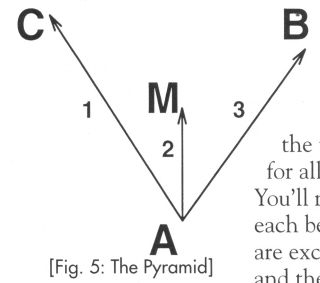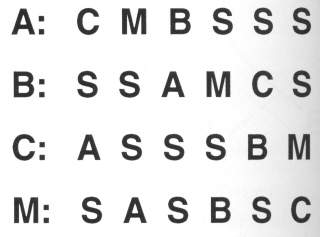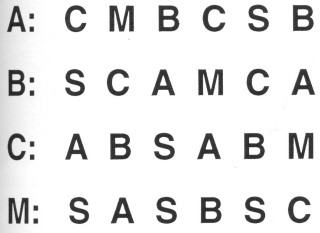The
first throw is quite
After
the first five throws, repeat the sequence mirror image (turn the L's
into R's in the table above), starting with a L to L self (thrown
outside) as your left hands begin to feed.
You
may notice that the sequence actually alternates selves and passes:
self, pass, self, pass, self (then it starts over with a self from the
(other hand). But it also goes around the perimeter of four hands
throwing to each one in turn, with the extra self from the other hand
added when necessary in the middle. The left hand feeds back around
the perimeter of hands in the opposite direction from the right hand.
The
second pass of each half (count 4) is a diagonal pass. Be sure to
throw it well outside, so that it doesn't collide with your partner's
identical pass. You can throw it from in front of your leg to help
avoid a collision.
The
final self (count 5) sets you up to start the feed over with the other
hand. Follow that self with a self thrown to the outside to be caught
by the same hand, then continue with the straight normal pass from
that hand, and go through the rest of the five-count sequence again.
Jim's Jam has a good rhythm. You'll master the pattern once your body feels and understands the rhythm. (This is true of most patterns. )
Jim's
Jam, Cheating You
don't like that weird first throw in Jim's Jam? Or you forget to make
it? No problem! This variation, which either or both partners can use
at any time in Jim's Jam, solves your problem (or makes it worse!).
The
variation only changes the first two counts of each half of the
pattern. Instead of doing the outside self throw on count 1, do a
normal self throw to the other hand. Then pass diagonally from that
hand to your partner. This diagonal pass arrives in the same hand that
your normal straight first Jim's Jam pass would have, so your partner
doesn't care that you've cheated. Now complete this half with the
normal last three throws: normal self, diagonal pass, normal self.
Remember to throw all diagonal passes well outside,
You
can cheat like this in either or both halves of the pattern, as can
your partner. You'll see that it doesn't change the fact that your
five throws are: self, pass, self, pass, self. If you cheat
continuously, you end each half-cycle
with a normal self and start the next with another. As you do Jim's
Jam, feel free to cheat now and then, either on just one side or on
both in sequence (hey, when was the
Hey,
instead of doing either normal self, how about throwing a straight
double pass and
For
a good mental challenge, try doing the following. Do the normal Jim's
Jam for 10 counts (one cycle) and then do the cheating variation for
10 counts. But do this while your partner is out of phase with you,
cheating when you're not and vice versa. Now you have a 20-count cycle
- work up to getting five cycles in a row without making a mistake.
This
cheating pattern is actually very similar to my Right-Right-Left-Left
pattern, described in Juggler's
Workshop, Summer
The
Pyramid A
couple of issues back, I described some patterns from the Madison Area
Jugglers. Here's another one, by Michael Newton, one of their creative
pattern folks. This pattern is relatively simple for three of the four
people involved - the fourth has to pass to those first three while
turning around.
The
Pyramid has three people in a triangle, with a fourth person standing
in the middle. Everyone gets to pass to everyone in a 6-beat sequence
(12 counts, if we pass only right handed, which we'll assume here).
Each of the corners does the same thing: three passes, then three
selves. The passes are in a typewriter pattern - that is, you feed the
three other people (from left to right - and then you do your three
selves. The
person in the middle passes every other beat (a 4-count here), each
time to a different person. In order to do that, the middle juggler
turns almost continuously, in a counterclockwise direction, stopping
only briefly if at all to exchange a club with each comer person
faced.
Fig.
5 shows the formation and the sequence of passes for one comer. Each
comer does the same sequence, but out of phase from
Fig.
6 shows
The
Great Pyramid This
is a more interesting (read challenging - though not terribly
difficult) version of the Pyramid. Whenever the middle person in the
Pyramid is passing to one person, the other two people are both doing
selves. So, what the heck, let's let those two exchange a pass.
Because each comer adds two more passes (one to each of the other two comers, replacing two selves in the original pattern), each corner now does almost a continuous typewriter feed (feeds the other three people from left to right). The only exception is the one remaining self, which comes every other time you would be passing to the middle juggler. That is, the corners do the following sequence, with five passes and one self per six -More- beat cycle: left, middle, right; left, self, right. Of course, as always the corners are two beats out of phase from each other. Fig. 7 shows the new table of throws. The middle person's pattern is the same as in the basic Pyramid.
One
hint: Make all inside passes long.
The
Ulti It's
difficult to take out the final selves in the Great Pyramid, but it is
possible if the middle person is able to rotate twice as fast as in
the above variations. In this case, the middle rotates in the opposite
direction (now clockwise) so that the middle person faces the comer
who is doing a self at the same time as
No,
I don't recommend adding lefts with the middle in this fast turning
version - that would gum up the works. Good luck.
By
the way, if you do this exact pattern but without any passes between
the corners (turn them into selves), you have the circle feed. The
middle person feeds everyone on the outside. This by itself is fairly
hard for the feeder if doing a 2-count with only three people on the
outside. It's interesting how, when we permute a pattern further and
further, we so often end up with a known pattern that we hadn't even
considered. If you have any comments or suggestions for Juggler's Workshop, write to: Juggler's Workshop, Palo Alto, CA or call Martin Frost. |




